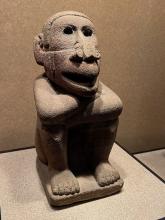Ecatl (Mdz12r)
This glyphic element featuring the divine force of the wind, Ehecatl, has been carved from the compound place name Ecatepec. This component of the place name is a bird-like head with a red beak (what some sources describe as a duck bill, but which was perceived by Nahuas to be a blowing device), a large red protrusion above the beak, possibly a purple beard below the beak, a turquoise head, and a large white eye. The head is shown in profile, looking to the viewer's left.
Stephanie Wood
The gloss gives "Ecatl," but the visuals suggest "Ehecatl." This is a recurring phenomenon across the glyphs from many manuscripts. Perhaps the reduplication was barely noticeable in spoken speech.
Ehecatl is a noun in Nahuatl that means wind, and the word was also a proper name for the deity of the wind. In turn this deity was an aspect of the creator (with Quetzalcoatl associations) and with the night. This representation of Ehecatl (which was also a name borne by some humans, given that it was a day sign in the calendar), was apparently how humans saw the deity associated with the wind. The second sun on the Aztec sun stone has a much more elaborate representation of the wind; this epoch was ruled by Quetzalcoatl. The second sun was destroyed by hurricanes and the people were turned into monkeys. For other images of Ehecatl and more information about his shape and that of Quetzalcoatl, see Mexicolore. One of the pre-Columbian statues devoted to the wind gives him a monkey's body but the same buccal mask (large point above the mouth or beak) as we see in this glyph. A type of hummingbird has the name ecahuitzilin, which shows another possible connection between the divine force associated with the wind and birds. But the ecahuitzilin seems to have coloring that is different from the visual aspect in this glyph.
Gabrielle Vail and Christine Hernández (Re-Creating Primordial Time, 2013, ) describe Ehecatl as the wind aspect of Quetzalcoatl, and they note that Ehecatl "wears a buccal (duck) mask through which to blow wind." That the "beak" may have been perceived as a blowing device is supported by the glyph for Pitztli (below).
John Montgomery drew a group of wind glyphs (possibly mainly Mixtec), showing the variety of ways the blowing device might look. It is published in FAMSI, Inc.
Stephanie Wood
c. 1541, but by 1553 at the latest
Stephanie Wood
wind, winds, deity, deities, Ecatl, Eecatl, Ehecatl, aire, viento, divinidades, deidades
Ehecatl. Figure of the divine forces of the wind or the deity, Ehecatl, Museo Nacional de Antropología e Historia, Salón Mexica. Photograph by Stephanie Wood, 14 February 2023.

eca(tl), air, breath, https://nahuatl.wired-humanities.org/content/ecatl
eheca(tl), wind or deity associated with the wind, https://nahuatl.wired-humanities.org/content/ehecatl
ecahuitzil(in), a type of bird, https://nahuatl.wired-humanities.org/content/ecahuitzilin
Ehecatl, the deity of the wind
Ehecatl, la diedad del viento
Stephanie Wood
Codex Mendoza, folio 12 recto, https://digital.bodleian.ox.ac.uk/objects/2fea788e-2aa2-4f08-b6d9-648c00..., image 34 of 188.
The Bodleian Libraries, University of Oxford, hold the original manuscript, the MS. Arch. Selden. A. 1. This image is published here under the UK Creative Commons, “Attribution-NonCommercial-ShareAlike 3.0 License” (CC-BY-NC-SA 3.0).






